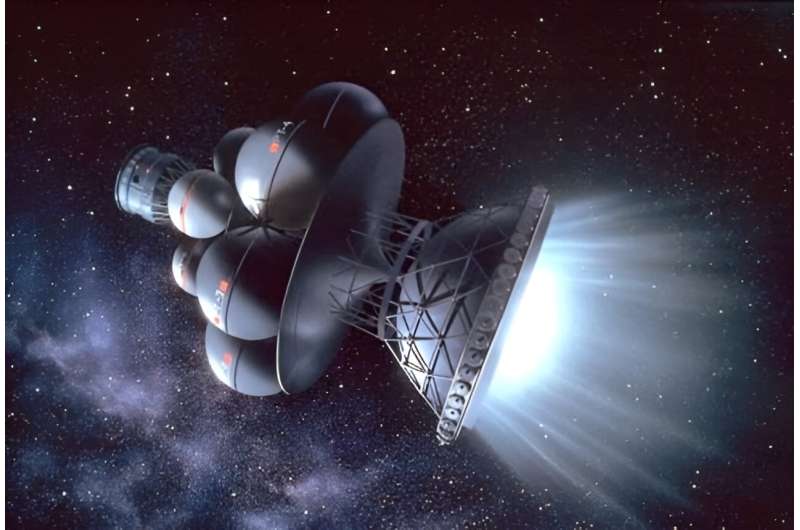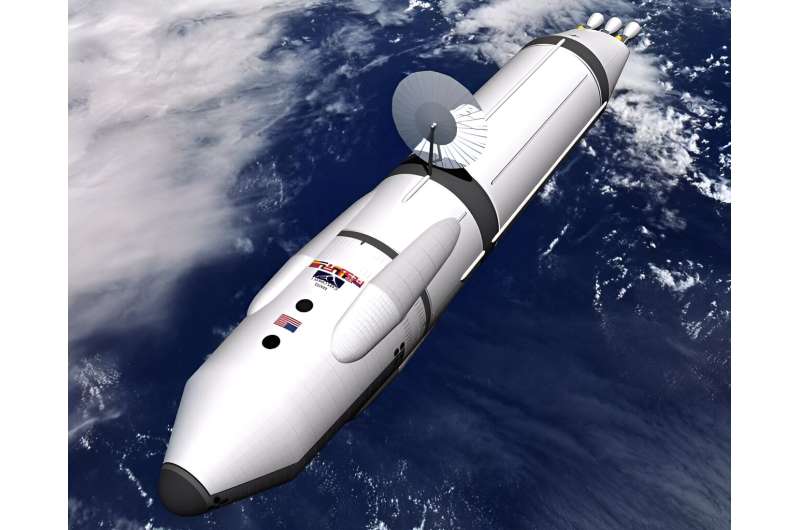This article has been reviewed according to Science X's editorial process and policies. Editors have highlighted the following attributes while ensuring the content's credibility:
fact-checked
preprint
trusted source
proofread
Magnetic fusion plasma engines could carry us across the solar system and into interstellar space

Missions to the moon, missions to Mars, robotic explorers to the outer solar system, a mission to the nearest star, and maybe even a spacecraft to catch up to interstellar objects passing through our system. If you think this sounds like a description of the coming age of space exploration, then you'd be correct.
At this moment, there are multiple plans and proposals for missions that will send astronauts and/or probes to all of these destinations to conduct some of the most lucrative scientific research ever performed. Naturally, these mission profiles raise all kinds of challenges, not the least of which is propulsion.
Simply put, humanity is reaching the limits of what conventional (chemical) propulsion can do. To send missions to Mars and other deep space destinations, advanced propulsion technologies are required that offer high acceleration (delta-v), specific impulse (Isp), and fuel efficiency.
In a recent paper, Leiden Professor Florian Neukart proposes how future missions could rely on a novel propulsion concept known as the Magnetic Fusion Plasma Drive (MFPD). This device combines aspects of different propulsion methods to create a system that offers high energy density and fuel efficiency significantly greater than conventional methods. The paper was published on the pre-print server arXiv.
Florian Neukart is an Assistant Professor with the Leiden Institute of Advanced Computer Science (LIACS) at Leiden University and a Board Member of the Swiss quantum technology developer Terra Quantum AG.
The pre-print of his paper is being reviewed for publication. According to Neukart, technologies that can surmount conventional chemical propulsion (CCP) are paramount in the present era of space exploration. In particular, these technologies must offer greater energy efficiency, thrust, and capability for long-duration missions.
This is especially true for missions to Mars and other locations beyond the Earth-moon system, which pose serious risks to astronaut health, safety, and well-being. Even when Earth and Mars are at their closest every 26 months (a Mars Opposition), it can take up to nine months to make a one-way transit to the planet.
Combined with surface operations that could last up to a year and the nine-month return trip, missions to Mars could last up to 900 days. During this time, astronauts will be exposed to elevated levels of cosmic and solar radiation, not to mention the toll of long periods spent in microgravity will have on their bodies.
Hence, NASA and other space agencies are actively investigating alternate means of propulsion. As noted in a previous article, "How Long Would It Take To Travel To The Nearest Star?," these concepts are also considered potential means for achieving interstellar travel for decades.
They include fuel-efficient concepts like electric or ion propulsion, which utilize electromagnetic fields to ionize inert propellant (like xenon gas) and accelerate it through nozzles to generate thrust. However, these concepts generally produce low thrust and must rely on heavy power sources (solar arrays or nuclear reactors) to generate more.
Solar sails are another option, which can generate continuous acceleration while requiring no propellant (thereby saving on mass). However, missions equipped with this technology are limited in terms of thrust and must operate closer to the sun. A twist on the idea is to employ Gigawatt-energy (GWe) laser arrays to accelerate spacecraft equipped with sails to relativistic speeds (a fraction of the speed of light). However, this concept requires expensive infrastructure and tremendous amounts of power in order to be feasible.
Another popular concept is nuclear thermal propulsion (NTP), which NASA and DARPA are currently developing in the form of the Demonstration Rocket for Agile Cislunar Operations (DRACO). This method relies on a nuclear reactor to heat propellant (like liquid hydrogen), causing it to expand through nozzles to generate thrust. The benefits of NTP include very high energy density and significant acceleration, but it also comes with numerous technical and safety challenges involving the handling and launching of nuclear materials.
There are also propulsion concepts that harness fusion reactions, like deuterium-tritium (D-T) and deuterium-hydrogen three (D-He3) reactions, something that theoretical scientists have been working with for decades. These methods offer the potential for high thrust and extremely high specific impulse but also present technical challenges, not the least of which are related to handling the necessary fuel and achieving sustained and controlled fusion reactions.
There are also more exotic concepts, like antimatter propulsion and the Alcubierre Warp Drive, but none of these will be available in the foreseeable future.

And there's Neukart's proposal, which combines elements of fusion propulsion, ionic propulsion, and other concepts. As he explained to Universe Today via email:
"The MFPD is a propulsion system for space exploration, utilizing controlled nuclear fusion reactions as a primary energy source for both thrust and potential electric power generation. The system is predicated on harnessing the immense energy output from fusion reactions, typically involving isotopes of hydrogen or helium, to produce a high-velocity exhaust of particles, thereby generating thrust according to Newton's third law.
"The plasma from the fusion reactions is confined and manipulated using magnetic fields, ensuring controlled energy release and directionality. Simultaneously, the MFPD concept envisages the possibility of converting part of the fusion energy into electrical power to sustain onboard systems and possibly the reaction control system of the spacecraft."
To develop this concept, Nuekart began with deuterium-tritium (D-T) fusion reactions since it is one of the most researched and understood reactions and offers a clear and familiar basis for elaborating the core principles and mechanics of MFPD.
Furthermore, Neukart added, D-T reactions have relatively low ignition temperatures and a higher cross-section than other concepts, making it a good "starting point." Therefore, they provide a useful benchmark for measuring and comparing the performance of this theoretical propulsion system.
However, the ultimate goal of MFPD is to harness aneutronic fusion (p-B11), where very little of the energy released by the reactions is carried by neutrons. Aneutronic reactions, in contrast, release energy in the form of charged particles (typically protons or alpha particles), thereby significantly reducing the level of neutron radiation produced.
The advantages of this system are immediately apparent, combining high specific impulse and immense energy density and providing both thrust and power from a single energy source. Other benefits, said Neukert, include the following:
- High specific impulse: The MFPD can provide a high-specific impulse, delivering substantial velocity change (delta-v) to the spacecraft, facilitating missions to distant celestial bodies.
- Energy-dense fuel: Fusion fuel, like isotopes of hydrogen, is incredibly energy-dense, potentially enabling extended missions without needing vast amounts of propellant.
- Lower mass fractions: The spacecraft might be designed with lower mass fractions dedicated to fuel storage, affording more mass allocation for scientific instruments or additional technologies.
- Dual utility: The MFPD is not just a propulsion system; it is also envisioned to provide electrical power for the spacecraft's systems and instruments, which is crucial for long-duration missions.
- Adaptability: The potential to adjust the thrust and specific impulse, offering versatility for different mission phases, such as acceleration, cruising, and deceleration.
- Reduced travel time: The potential for higher continuous thrust may significantly reduce transit times to distant destinations, mitigating risks related to cosmic radiation exposure and onboard resource management.
- Radiation shielding: Although challenging, the inherent magnetic and physical structures might be engineered to provide some level of radiation shielding for the spacecraft and crew, utilizing the plasma and magnetic fields.
- Independence from solar proximity: Unlike solar sails or solar electric propulsion, the MFPD does not depend on proximity to the sun; thus, it is viable for missions into the outer solar system and beyond.
- Minimized risk of nuclear contamination: Compared to nuclear-thermal or fission-electric concepts, the MFPD could be designed to minimize the risk of radioactive contamination, given that fusion, in general, requires less radioactive material and potentially allows for safer reactor shutdown.
As to the implications this system could have for space exploration, Nuekart emphasized the ability to traverse vast cosmic distances in reduced timeframes, expanding mission profiles (fast transits to other planets in the solar system and interstellar missions), mitigating the risks of long-duration space missions (exposure to radiation and microgravity), revolutionizing spacecraft design by providing propulsion and electrical power simultaneously, and enhancing human exploration capabilities.
Beyond that, he also foresees the potential for technological spin-offs in materials science, plasma physics, and energy production that could have applications here on Earth. The development of this system could also foster international collaborations, bringing experts and resources from multiple fields together to realize common exploratory objectives.
Of course, no next-generation technology proposal would be complete without some caveats and addendums. For instance, said Nuekart, the main challenge for MFPD propulsion lies in achieving and maintaining stable fusion relations in space.
On Earth, researchers have made considerable progress with magnetic confinement (MCF) and inertial confinement fusion (ICF). The former involves Tokamok reactors using magnetic fields to confine fusion in the form of plasma, while the latter relies on lasers to compress and heat tablets of D-T fuel.
However, similar experiments have not been conducted in space, leading to questions about how the system will handle heat caused by reactions, the resulting radiation, and the structural implications for spacecraft. Nevertheless, the ball is already rolling on nuclear tests in space (the aforementioned DRACO demonstrator).
Given the benefits of fusion propulsion, it's not likely to remain on the drawing board for long. Ultimately, says Nuekart, the research into MFPD aims to establish a pathway that will lead to interplanetary and (someday) Interstellar exploration:
"While the journey to realize the MFPD concept will undeniably be layered with challenges and scientific hurdles, the potential payoff is monumental. Achieving reliable, effective, and efficient fusion propulsion could redefine the boundaries of achievable goals, propelling humanity into a new era of exploration, discovery, and understanding of the cosmos."
"The hope is that the research seeds curiosity, innovation, and determination among scientists, engineers, and explorers across the globe, charting the course toward our future among the stars."
More information: Florian Neukart, Magnetic Fusion Plasma Drive, arXiv (2023). DOI: 10.48550/arxiv.2309.11524
Journal information: arXiv
Provided by Universe Today





















